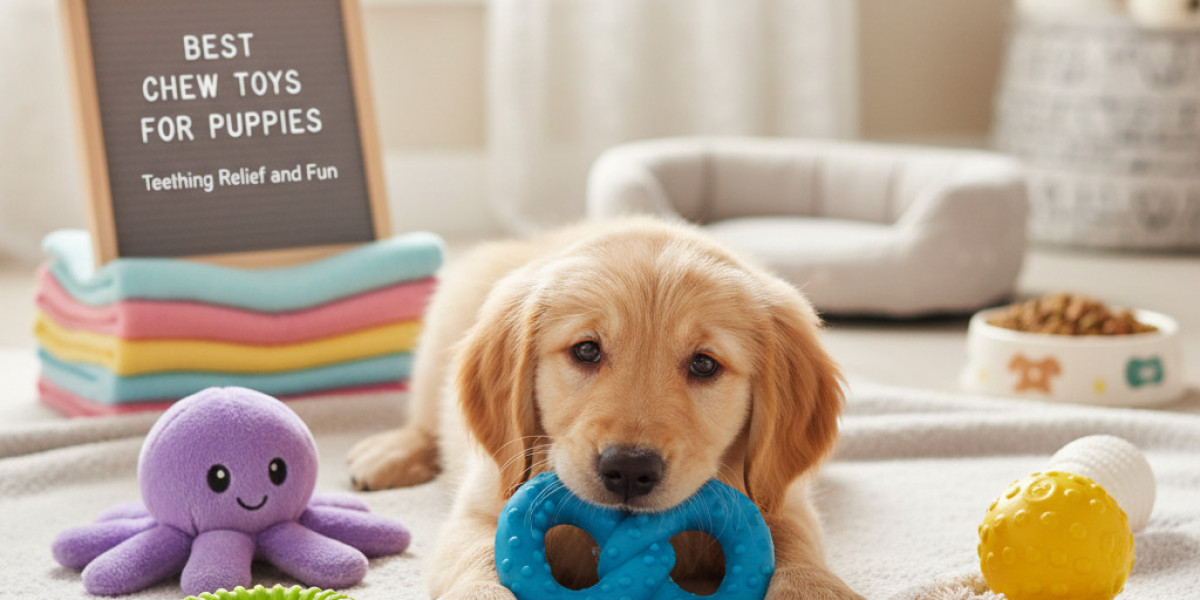Puppies explore the world through their mouths. From shoes and furniture to anything that smells interesting, nothing seems safe when a teething puppy is around. Chewing is a natural and essential part of a puppy’s growth, helping relieve discomfort during teething and keeping developing jaws strong. The right chew toys not only protect your belongings but also provide safe, engaging ways for puppies to play and learn. Choosing the right toys makes a big difference in both your puppy’s happiness and your peace of mind.
Why Puppies Need Chew Toys
Teething begins when puppies are about three to four months old and continues until they are around seven months. During this phase, new teeth push through the gums, causing soreness and irritation. Chewing provides a natural way to soothe that discomfort. It also strengthens their jaw muscles and helps teeth grow in properly.
Without proper chew toys, puppies often turn to whatever they can find. This can lead to damaged furniture, electrical cords, or even swallowed objects that may cause choking or stomach problems. Offering suitable chew toys redirects that natural urge toward something safe and satisfying.
What Makes a Good Chew Toy for Puppies
Not all toys are created equal. The best chew toys combine safety, durability, and fun. Size is one of the most important factors to consider. A toy that’s too small can become a choking hazard, while one that’s too hard might hurt developing teeth. Look for toys that are made specifically for puppies — these are usually softer and gentler on gums but strong enough to handle light chewing.
Toys made from natural rubber, nylon, or soft silicone are popular because they last longer and are easy to clean. Some are even designed to be frozen, providing extra relief for sore gums. Textured surfaces or ridges can massage gums and promote dental health, while toys that make sounds or hold treats can keep puppies engaged for longer play sessions.
Types of Chew Toys for Teething Puppies
1. Rubber Chew Toys
Rubber toys are durable and versatile. They come in various shapes, from bones to balls, and can often be filled with treats or peanut butter for added excitement. The flexibility of rubber makes it safe for teething pups, reducing the risk of breaking teeth.
2. Rope Toys
Rope toys are great for tugging and chewing. The fibers help clean teeth as puppies gnaw on them, promoting better oral hygiene. Always supervise playtime with rope toys to make sure loose threads aren’t swallowed.
3. Plush Chew Toys
Soft toys are comforting for young puppies who are adjusting to a new home. While they aren’t as durable as rubber or nylon options, plush toys are gentle on sore gums and often double as cuddle companions. Choose high-quality plush toys with reinforced stitching to prevent tearing.
4. Freezable Teething Toys
Cold helps numb sore gums, making freezable toys an excellent choice during the peak teething stage. These toys can be filled with water and chilled before playtime. The soothing coldness provides instant relief and keeps puppies occupied.
5. Treat-Dispensing Toys
Interactive toys that release treats or kibble combine fun and training. Puppies stay busy trying to get the reward, which helps them learn problem-solving and keeps them mentally stimulated.
Common Mistakes to Avoid When Choosing Chew Toys
Using household items like old socks or shoes as toys may seem harmless, but it confuses puppies. They cannot tell the difference between what belongs to them and what doesn’t. This can lead to destructive chewing habits later on.
Avoid toys that are too hard, such as bones or antlers, which can crack developing teeth. Cheap toys made with toxic materials or small detachable parts can also pose choking risks. Always check the label for pet-safe materials and supervise your puppy during play.
Another mistake is keeping too few toys around. Puppies get bored quickly, and rotating toys every few days keeps playtime fresh and exciting.
The Role of Chew Toys in Training and Development
Chew toys are not just for teething relief; they also teach puppies good behavior. Rewarding them for chewing the right toys reinforces positive habits. Over time, this helps reduce anxiety, boredom, and destructive behavior.
Interactive chew toys can be part of obedience training. Giving a toy after a command or using it as a distraction during stressful situations helps puppies stay calm and focused. It builds trust and strengthens the bond between pet and owner.
Cleaning and Maintenance Tips
Keeping chew toys clean prevents bacteria buildup and extends their lifespan. Wash rubber and silicone toys with warm, soapy water after use. Rope toys can often be machine washed, while plush toys may require gentle handwashing. Regular cleaning also helps identify damage early so you can replace toys before they become unsafe.
Having multiple toys makes cleaning easier because you can rotate them while others dry. Fresh, clean toys encourage more active play and protect your puppy’s health.
Conclusion
Teething is a temporary stage, but the habits formed during it last a lifetime. The best chew toys offer relief, encourage good behavior, and support healthy development. Investing in quality toys made for puppies saves your furniture and keeps your young pet happy and comfortable.
Chewing is a natural instinct, not a problem to stop, but a behavior to guide. With the right selection of toys, every nibble becomes a learning experience, every game becomes bonding time, and every chew helps your puppy grow into a strong, well-behaved companion.







